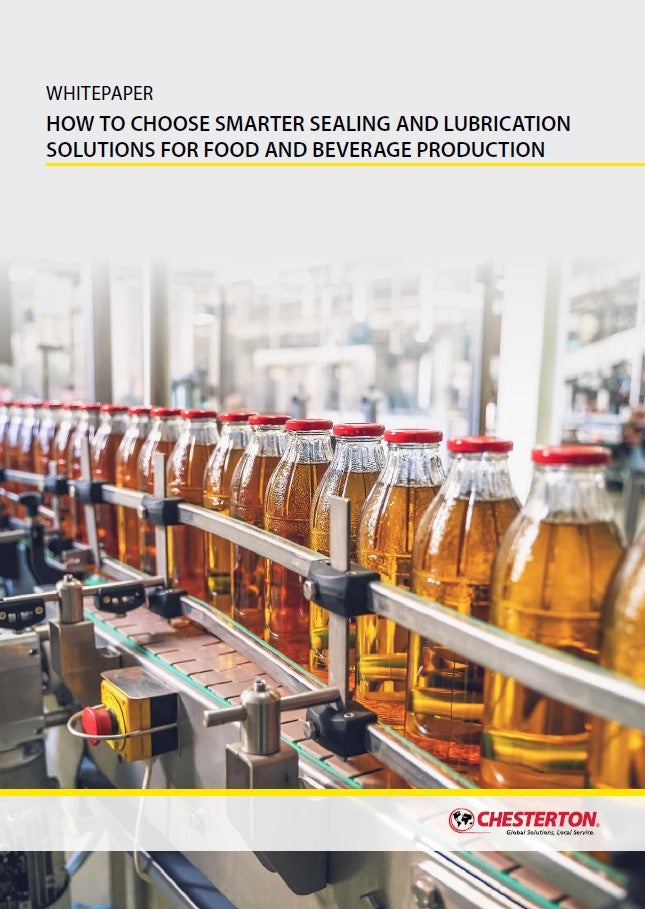
Thanks to the rising global interest in saving the environment and the importance of corporate social responsibility, companies are now looking for more sustainable and earth-friendly ways to produce food and beverages.

How to choose Smarter Sealing and Lubrication Solutions for Food and Beverage Production
The food and beverage industry has to overcome many challenges to consistently provide safe, high-quality products. Stringent compliance legislation together with demand from consumers for ever-increasing varieties creates a uniquely complex expectation management landscape.
At the heart of food and beverage processing sits a small yet vital component: the humble seal. These play critical roles in ensuring impeccable segregation of a variety of materials. They must be able to achieve this no matter what size, temperature, application, media, pressure or processing speed is required.
Download this whitepaper to understand the importance of the right seal and lubrication solution for any F&B equipment.
Thank you.Please check your email to download the Whitepaper.
However, sustainable alternatives still need to deliver high performance and support the peak efficiency of production machinery. Luckily, innovative biodegradable and food-grade lubricants are already available for the industry to consider.
Defining biodegradability and food-grade lubricants
Being biodegradable means that materials decompose by simply encountering naturally occurring bacteria within soil and water. There are several categories of biodegradability, ranked by how quickly materials break down during a range of laboratory tests over 28 days.
The highest category of biodegradability is readily biodegradable, as these materials break down to at least 60 per cent in as little as ten days. It’s worth noting that if a material is biodegradable, it does not necessarily mean it is safe for landfills or waterways. Toxicity should also be taken into consideration.
Regarding food-grade lubricants, there are three main categories:
- Those that might contact food
- Those that have no contact with food
- Those used for cleaning production equipment.
The primary category is NSF H1, and it is the default for food safety compliance where the lubricant could contact food. These lubricants are tasteless, odourless, non-reactive, and safe for human consumption. While the NSF H2 category is also food-grade and non-toxic, it is not necessarily food safe. Category NSF H3 lubricants are used only to clean food production equipment.
Not all lubricants are equal
While NSF H1 lubricants are predominantly used in food and beverage production machinery, not all NSF H1 lubricants are the same. There can still be significant differences in performance properties around detergency, water dispersion, and they can sometimes contain ingredients that cause irritation during production.
When considering which food-grade lubricant to use, it’s essential to check that it is the right technology for the application. Some lubricants may not meet all the performance requirements needed for specific applications; there could be a better alternative available.
Additional questions you should be asking yourself include how much lubrication is the right amount and how often should it be applied. You should also check to see if it is well supported by your supplier with the right kind of delivery and training.
Think about maintenance requirements and any performance properties that can help to reduce unnecessary downtime. Then it will be a case of how to monitor and adjust to get the best results.
Innovative and sustainable lubrication solutions
A.W. Chesterton Company has been a world leader in innovative sealing and lubrication solutions for the food and beverage industry for over 130 years. The Chesterton® 650 Advanced Machinery Lubricant (650 AML) is one example where innovation and sustainability come together. As an NSF H1 lubricant, it is food safe, has excellent water absorption and displacement properties, has detergency, is odourless, and is readily biodegradable.
To learn more about how customers are improving efficiency and worker environments after switching from USP white oil to 650 AML, download the whitepaper below.

How to choose Smarter Sealing and Lubrication Solutions for Food and Beverage Production
The food and beverage industry has to overcome many challenges to consistently provide safe, high-quality products. Stringent compliance legislation together with demand from consumers for ever-increasing varieties creates a uniquely complex expectation management landscape.
At the heart of food and beverage processing sits a small yet vital component: the humble seal. These play critical roles in ensuring impeccable segregation of a variety of materials. They must be able to achieve this no matter what size, temperature, application, media, pressure or processing speed is required.
Download this whitepaper to understand the importance of the right seal and lubrication solution for any F&B equipment.
Thank you.Please check your email to download the Whitepaper.
